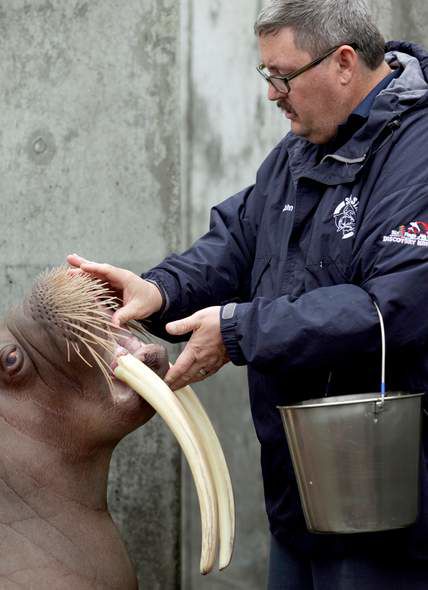Scientists’ goal: walrus babies
Published 4:00 am Wednesday, January 12, 2011

- Aquarium manager John Shultz examines the mouth of female walrus Uquq at Six Flags Marine World in Vallejo, Calif., on Dec. 28.
SAN JOSE, Calif. — He’s strong, healthy and hirsute. She’s social and friendly, with Rubenesque curves.
Yet the dalliances of this walrus pair have failed to yield a baby, a fact that confounds experts at Vallejo, Calif.-based Six Flags Discovery Kingdom, which seeks to breed the rare and mysterious species. So scientists are now making the first-ever attempt at artificial insemination — if only they can persuade male Sivuqaq, a rambunctious creature the size of a Volkswagen, to donate sperm.
“Once we get the sperm, we’re good to go,” marine mammal reproductive physiologist Holley Muraco said. “I feel confident that we’re going to have walrus babies.”
The love lives of Pacific walruses have long been shrouded in secrecy. They mate underwater, at remote, vast and icy habitats, during the Arctic Circle’s longest and darkest nights.
And there is growing concern for their survival because sea ice is melting. Zoos don’t want to collect from these perilous wild populations, and seek instead to increase the genetic diversity of their captive populations.
In the eight decades that walruses have been kept captive, only 11 babies have been born; of those, merely six survived. Fewer than 20 now exist in American zoos, and many are aging, Muraco said.
Hopes are pinned on Sivuqaq and Siku, or perhaps another female, Uquq — among America’s youngest and healthiest captive walruses. Orphaned when their mothers were killed during an Eskimo hunt, they were recovered off the coast of Gamble, Alaska, near St. Lawrence Island.
So far, they’ve been star-crossed, their cycles sadly out of sync. Siku and Uquq produce eggs just once a year — in the spring. But Sivuqaq is most romantic in the winter, when their ardor has faded.
“The females ovulate like champs,” Muraco said. “But there’s nothing to give them. His good stuff happens later.”
So the team is trying to align the reproductive cycles artificially.
They’ve identified what stirs Sivuqaq’s passion: Strollers. Running children. A nearby recycling bin. Power tools.
“He loves it when workmen are doing something loud with hammers and drills,” Muraco said. “It is almost a territorial thing. He’ll puff up and make groans, whistles and a low growl.”
At 30 pounds at 3 feet long, walruses have the largest reproductive organs in the mammalian world, Muraco said. But finding a super-sized artificial female organ has proved a bigger challenge. They’ve decided to custom-build their own out of a big PVC pipe, cushioned inside to prevent injury and equipped with valves to allow the flow of warm water.
Their final task will be building a mount — a fake female walrus — that’s sturdy enough to support his 2,900 pounds, yet fuzzy enough to put him in the mood.
“We better figure out something soon,” Muraco said. “We can learn from these trained animals, and use it to help endangered species … and put the research out there for others. We owe it to the world.”






